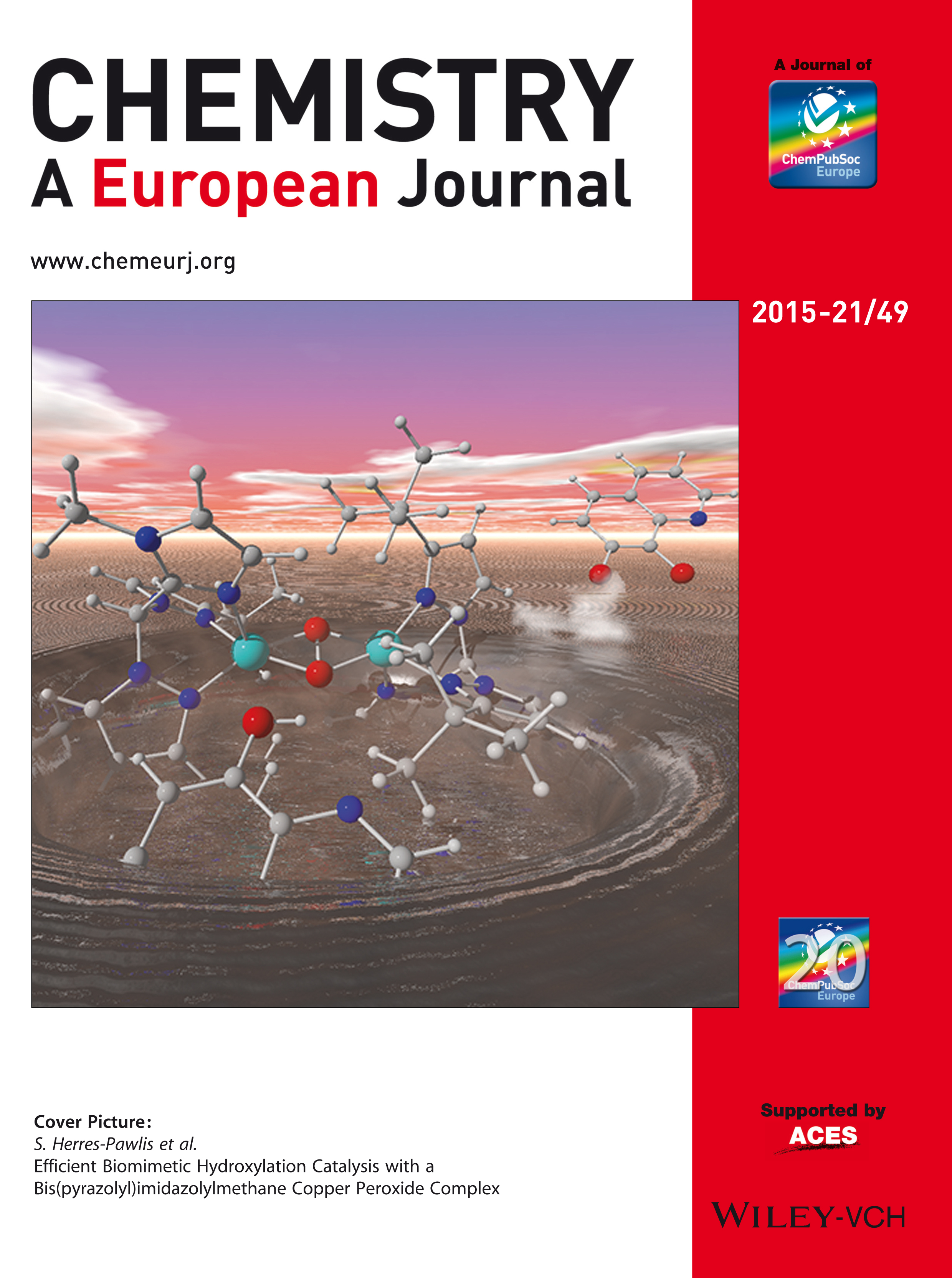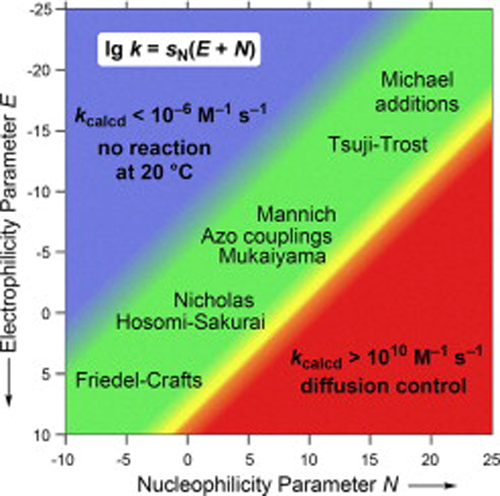Research Area B
Publications 2015
30-Oct-2015
Kinetics of the reactions of enolate anions derived from acyclic and cyclic β-keto esters with benzhydrylium ions and quinone methides have been determined photometrically in dimethyl sulfoxide solution at 20 °C. The reactions follow second-order rate laws: first-order with respect to the electrophile and first-order with respect to ... READ MORE
29-Oct-2015

A series of bis(pyrazolyl)methane copper complexes were found to catalyze a fast palladium-free Sonogashira coupling reaction of several iodoarenes with terminal alkynes such as phenylacetylene, propargyl benzyl ether, and (tert-butyl-dimethyl)silylacetylene. These reactions proceed with ... READ MORE
12-Oct-2015
Bis(pyrazolyl)methane ligands are excellent components of model complexes used to investigate the activity of the enzyme tyrosinase. Combining the N donors 3-tert-butylpyrazole and 1-methylimidazole results in a ligand that is capable of stabilising a (μ-η2:η2)-dicopper(II) core that resembles the ... READ MORE
15-Sep-2015
Iron-catalyzed oxidative α-cyanations at tertiary allylamines in the allylic position are followed by anti-Markovnikov additions of alcohols across the vinylic CC double bonds of the initially generated α-amino nitriles. These consecutive reactions generate 2-amino-4-alkoxybutanenitriles from three reactants (allylamines, trimethylsilyl cyanide, and alcohols) in ... READ MORE
24-Aug-2015
We investigate the photoinduced dynamics of perylene diimide dyads based on a donor–spacer–acceptor motif with polyyne spacers of varying length by pump–probe spectroscopy, time resolved fluorescence, chemical variation and quantum chemistry. While the dyads with pyridine based polyyne spacers undergo energy transfer with ... READ MORE
28-Jul-2015
Eight substituted aryl(indol-3-yl)methylium tetrafluoroborates 3(a–h)-BF4 and three bis(indol-3-yl)methylium tetrafluoroborates 3(i–k)-BF4 have been synthesized and characterized by NMR spectroscopy and X-ray crystallography. Their reactions ... READ MORE
16-Jul-2015
Natural products comprise a rich source for bioactive molecules with medicinal relevance. Many of these contain electrophilic scaffolds that bind conserved enzyme active sites covalently. Prominent examples include beta-lactams and beta-lactones, which specifically acylate serine residues in diverse peptidases. Although these scaffolds ... READ MORE
22-May-2015
14-May-2015
Boron-ate complexes derived from primary and secondary boronic esters and aryllithiums have been isolated, and the kinetics of their reactions with carbenium ions studied. The second-order rate constants have been used to derive nucleophilicity parameters for the boron-ate complexes, revealing that nucleophilicity increased with (i) electron-donating aromatics on ... READ MORE
07-May-2015
The influence of the metal on the nucleophilic reactivities of indenyl metal compounds was quantitatively determined by kinetic investigations of their reactions with benzhydrylium ions (Ar2CH+) and structurally related quinone methides. With the correlation equation ... READ MORE
08-Apr-2015
A biomimetic total synthesis of santalin Y, a structurally complex but racemic natural product, is described. The key step is proposed to be a (3+2) cycloaddition of a benzylstyrene to a “vinylogous oxidopyrylium”, which is followed by an intramolecular Friedel–Crafts reaction. This cascade generates the unique oxafenestrane framework of the target molecule ... READ MORE
09-Mar-2015
The linear free energy relationship log k = sN(N + E) (eq. 1), in which E is an electrophilicity, N is a nucleophilicity, and sN is a nucleophile-dependent sensitivity parameter, is a reliable tool for predicting rate constants of bimolecular electrophile-nucleophile combinations. Nucleophilicity scales that ... READ MORE
09-Mar-2015
Polytwistane is an intriguing hydrocarbon nanorod that has not been experimentally realized to date. To facilitate its identification in complex reaction mixtures, the ¹H and ¹³C nuclear magnetic resonance (NMR) spectra of idealized polytwistane were calculated using two distinct quantum chemical approaches. In addition, the NMR spectra of related hydrocarbon ... READ MORE
06-Feb-2015
Ultraviolet (UV) radiation is a leading external hazard to the integrity of DNA. Exposure to UV radiation triggers a cascade of chemical reactions, and many molecular products (photolesions) have been isolated that are potentially dangerous for the cellular system. The early steps that take place after UV absorption by DNA have been studied by ultrafast spectroscopy. ... READ MORE
21-Jan-2015
Boron ate complexes derived from thienyl and furyl boronic esters and aryllithium compounds have been isolated and characterized by X-ray crystallography. Products and mechanisms of their reactions with carbenium and iminium ions have been analyzed. Kinetics of these reactions were monitored by UV/Vis spectroscopy, and the influence of the aryl substituents, the diol ... READ MORE
19-Jan-2015
The synthesis of novel, chignolin-derived peptides comprising the azobenzene photoswitch [3-(3-aminomethyl)phenylazo]phenylacetic acid (AMPP) is reported. Reversible photoswitching behavior led to folding into β-hairpin-like structures, as unequivocally demonstrated by CD, FT-IR and NMR spectroscopy. ... READ MORE
12-Jan-2015
Secondary alkyllithium reagents bearing an OTBS group (TBS=tert-butyldimethylsilyl) at the 3-position can be prepared stereoconvergently through an I/Li exchange from a diastereomeric mixture of the corresponding secondary alkyl iodides. These lithium reagents react with a range of electrophiles, including carbon electrophiles, with retention of configuration to ... READ MORE
01-Jan-2015
Equilibria for the reactions of benzhydryl cations (Ar2CH+) with phosphines, tert-amines, pyridines, and related Lewis bases were determined photometrically in CH2Cl2 and CH3CN solution at 20 °C. The measured equilibrium constants can be expressed by the sum of two parameters, defined as the Lewis Acidity (LA) of the benzhydrylium ions and the Lewis basicity (LB) of ... READ MORE
An exchange system is presented, which allows ultrafast experiments with high excitation rates (1 kHz) on samples with reaction cycles in the range of a few seconds and small sample volumes of about 0.3 ml. The exchange is accomplished using a commercially available cuvette by the combination of a special type of magnetic stirring with transverse translational motion ... READ MORE



